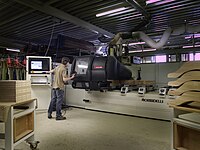
Photo from wikipedia
During the machining process, the computer numerical control machine is susceptible to variations in ambient temperature, cutting heat, and friction within the transmission parts, which generate different heat sources. These… Click to show full abstract
During the machining process, the computer numerical control machine is susceptible to variations in ambient temperature, cutting heat, and friction within the transmission parts, which generate different heat sources. These heat sources affect the machine structure in different ways, causing deformation of the machine and displacement of the tooltip and workpiece position, ultimately resulting in deviations in machining accuracy. The amount of thermal drift depends on several factors, including the material of the machine components, the cutting conditions, the duration of the machining process, and the environment. This study proposes a hybrid optimization algorithm to optimize the thermal variables of computer numerical control machine tool spindles. The proposed approach combines regression analysis and fuzzy inference to model the thermal behavior of the spindle. Spindle speed and 16 temperature measurement points distributed on the machine are input factors, while the spindle's axial thermal error is considered an output factor. This study develops a regression equation for each speed to account for the different temperature rise slopes and spindle thermal variations at different speeds. The experimental results show that the hybrid thermal displacement compensation framework proposed in this study effectively reduces the thermal displacement error caused by spindle temperature variation. Furthermore, the study finds that the model can be adapted to significant variations in environmental conditions by limiting the machining speed range, which significantly reduces the amount of data needed for model adaptation and shortens the adaptation time of the thermal displacement compensation model. As a result, this framework can indirectly improve product yield. The effects observed in this study are remarkable.
Journal Title: Science progress
Year Published: 2023
Link to full text (if available)
Share on Social Media: Sign Up to like & get
recommendations!